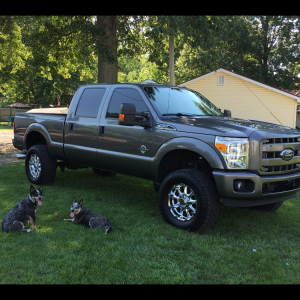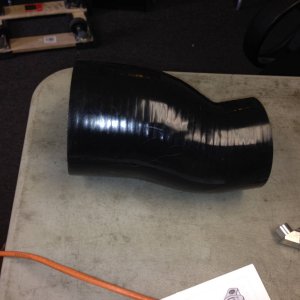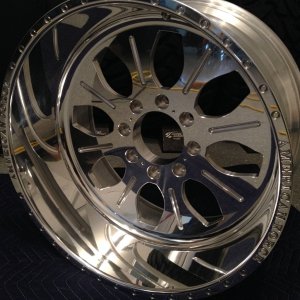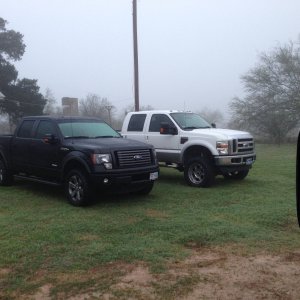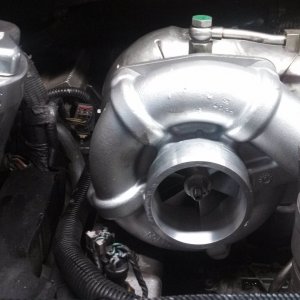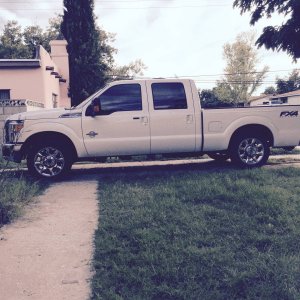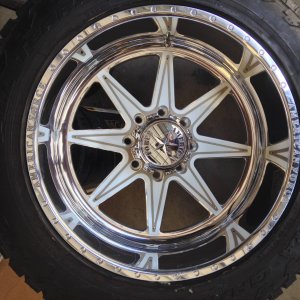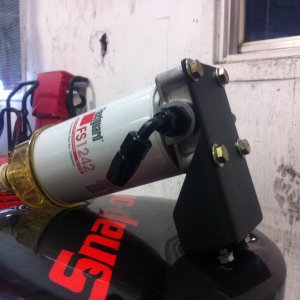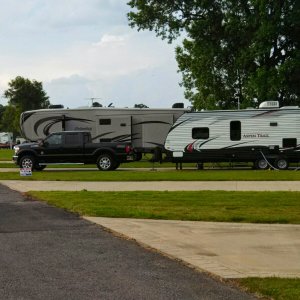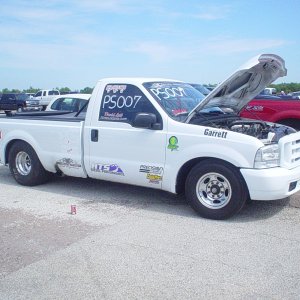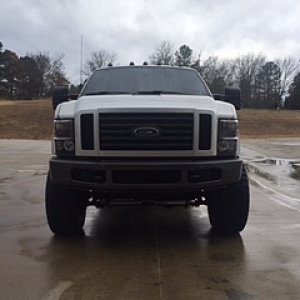Power Hungry
Member
Okay... So I finally got off my lazy butt this morning and went over to the shop to test the new Gen 2 Wicked Wheel (that's MY name for it...) I got from Bob Riley last week while at PRI. (PRI, by the way, was AWESOME! Great show this year.) The original Wicked Wheel is familiar to most Power Stroke guys as the inexpensive wheel that helps eliminate Compressor Surge under certain conditions. What is Compressor Surge? I'm glad you asked. Compressor Surge is the condition in which air being drawn into the turbo stalls and "burps" back out the inlet. This is similar to Cavitation, a common problem in boating where the propeller is unable to properly channel water through the blades. This video shows what Compressor Surge sounds like on a stock Garrett turbo...
http://www.youtube.com/watch?v=8OtV3bunOYE
Anyway, the original Wicked Wheel was extremely effective in removing the surging, but in some instances it also lost a couple PSI of boost as well. This was generally accepted as the price to pay for the elimination of Compressor Surge. Not anymore.
The new wheel is a pretty drastic departure from both the stock compressor wheel and the original Wicked Wheel. These images show just how radical the new design is...
Stock (Click on images to enlarge)...


Gen 1 Wicked Wheel (Click on images to enlarge)...


Gen 2 Wicked Wheel (Click on images to enlarge)...


The pictures clearly show the effectiveness of the new design, but what I didn't expect were the results we achieved when we put this little puppy on my truck today.
Just for reference, my test mule is a 2001 F250 7.3L with 240,000 miles on the original PMR engine. I am currently running a set of Stage 1 Single shot injectors, stock HPOP, stock turbo, stock fuel system, Tymar intake, and 4" exhaust. When I say it's nothing special, I mean it. It's a solid daily driver and that's all I expect from it.
I pulled the truck on the dyno this morning to get some current baseline power numbers. After a few runs in both a 100 Performance and 140 Extreme program, I climbed in and started pulling the turbo off. I am seriously wondering if in 240,000 miles this turbo has never been off because that back clamp on the turbo was a freaking SOB to get off. I don't think I've EVER had one fight me that bad, and I've done quite a few!! :doh: After finally yanking the turbo off, I split the housing off the exhaust and then removed the compressor housing. The stock compressor wheel actually looked quite impressive given its age, and a quick test of the turbo shaft end play and lateral play set my mind at ease as to the reliability of the turbo itself. A quick spin and the new wheel was in place, and after replacing the compressor housing I made sure the new wheel wasn't going to turn into a high speed router and mill the housing to bits. 20 minutes later and the turbo was all snug and nestled back in its little hole. Time to see what's what. :lookaround:
I fired the truck up and let everything settle back in. Gotta make sure them turbo bearings are nice and lubed up before I go thrashing it. About the time I got the tools cleaned up and put away, the truck was ready for some [more] abuse. I started off with a surge test, similar to the one I did before taking the turbo off. Locked in 4th with the converter locked, I loaded up the dyno and rolled into the throttle. No doubt about it... The surge was gone! Check this video...
http://www.youtube.com/watch?v=2S913a-g8iQ
We wasted a couple runs just to get the EOT up to operating temp and then we got serious and started dynoing. What I discovered was astounding. First off, on the 100 HP tune we picked up a solid 20 HP with no other changes! On the 140 HP tune, we picked up a peak of 12 HP and almost 20 HP above 2500 RPM. However, this is nothing compared to the fact that the boost output jump from about 30-31 PSI at 3400 RPM to 43 PSI!! Can you say "Holy Crap?" I know I did! Check this video...
Check this video...
http://www.youtube.com/watch?v=fLjNd8Ky9TA
Now, keep in mind that my truck already runs pretty darn clean. I don't have any excess fuel to speak of, so the turbo is basically squeezing the last ounce of efficiency out of the fuel I do have. I am EXTREMELY curious as to how this would react to a truck with 180cc, 200cc, or larger injectors installed. Imagine... an otherwise Stock turbo being able to handle 200cc+ injectors without any real issue? It's staggering. Looks like I might have to retire the Stage 1's and step up to the plate for some Stage 3 Hybrids. Who knows, I may even be able to have a reliable 500 HP daily driver on a thrashed 240,000 mile PMR engine. At least I know the tuning won't be an issue. With my trusty dyno and CP tester on hand, I may even go for 600 HP. I seriously doubt a stock turbo will accomplish that, though, regardless of what wheel we put on it. Haa haa haa. At that point, it might be time for a B/W S472 or maybe twins. We'll see. I'm still monkeying around with the 6.0L and have some more things to do with that before I play with the 7.3L any further.
I'm still going through all the datalog information and will have some of that to post up later this weekend. In the meantime, pull up a chair and enjoy the videos. opcorn:
opcorn:
Take care.
http://www.youtube.com/watch?v=8OtV3bunOYE
Anyway, the original Wicked Wheel was extremely effective in removing the surging, but in some instances it also lost a couple PSI of boost as well. This was generally accepted as the price to pay for the elimination of Compressor Surge. Not anymore.
The new wheel is a pretty drastic departure from both the stock compressor wheel and the original Wicked Wheel. These images show just how radical the new design is...
Stock (Click on images to enlarge)...
Gen 1 Wicked Wheel (Click on images to enlarge)...
Gen 2 Wicked Wheel (Click on images to enlarge)...
The pictures clearly show the effectiveness of the new design, but what I didn't expect were the results we achieved when we put this little puppy on my truck today.
Just for reference, my test mule is a 2001 F250 7.3L with 240,000 miles on the original PMR engine. I am currently running a set of Stage 1 Single shot injectors, stock HPOP, stock turbo, stock fuel system, Tymar intake, and 4" exhaust. When I say it's nothing special, I mean it. It's a solid daily driver and that's all I expect from it.
I pulled the truck on the dyno this morning to get some current baseline power numbers. After a few runs in both a 100 Performance and 140 Extreme program, I climbed in and started pulling the turbo off. I am seriously wondering if in 240,000 miles this turbo has never been off because that back clamp on the turbo was a freaking SOB to get off. I don't think I've EVER had one fight me that bad, and I've done quite a few!! :doh: After finally yanking the turbo off, I split the housing off the exhaust and then removed the compressor housing. The stock compressor wheel actually looked quite impressive given its age, and a quick test of the turbo shaft end play and lateral play set my mind at ease as to the reliability of the turbo itself. A quick spin and the new wheel was in place, and after replacing the compressor housing I made sure the new wheel wasn't going to turn into a high speed router and mill the housing to bits. 20 minutes later and the turbo was all snug and nestled back in its little hole. Time to see what's what. :lookaround:
I fired the truck up and let everything settle back in. Gotta make sure them turbo bearings are nice and lubed up before I go thrashing it. About the time I got the tools cleaned up and put away, the truck was ready for some [more] abuse. I started off with a surge test, similar to the one I did before taking the turbo off. Locked in 4th with the converter locked, I loaded up the dyno and rolled into the throttle. No doubt about it... The surge was gone! Check this video...
http://www.youtube.com/watch?v=2S913a-g8iQ
We wasted a couple runs just to get the EOT up to operating temp and then we got serious and started dynoing. What I discovered was astounding. First off, on the 100 HP tune we picked up a solid 20 HP with no other changes! On the 140 HP tune, we picked up a peak of 12 HP and almost 20 HP above 2500 RPM. However, this is nothing compared to the fact that the boost output jump from about 30-31 PSI at 3400 RPM to 43 PSI!! Can you say "Holy Crap?" I know I did!
http://www.youtube.com/watch?v=fLjNd8Ky9TA
Now, keep in mind that my truck already runs pretty darn clean. I don't have any excess fuel to speak of, so the turbo is basically squeezing the last ounce of efficiency out of the fuel I do have. I am EXTREMELY curious as to how this would react to a truck with 180cc, 200cc, or larger injectors installed. Imagine... an otherwise Stock turbo being able to handle 200cc+ injectors without any real issue? It's staggering. Looks like I might have to retire the Stage 1's and step up to the plate for some Stage 3 Hybrids. Who knows, I may even be able to have a reliable 500 HP daily driver on a thrashed 240,000 mile PMR engine. At least I know the tuning won't be an issue. With my trusty dyno and CP tester on hand, I may even go for 600 HP. I seriously doubt a stock turbo will accomplish that, though, regardless of what wheel we put on it. Haa haa haa. At that point, it might be time for a B/W S472 or maybe twins. We'll see. I'm still monkeying around with the 6.0L and have some more things to do with that before I play with the 7.3L any further.
I'm still going through all the datalog information and will have some of that to post up later this weekend. In the meantime, pull up a chair and enjoy the videos.
Take care.

